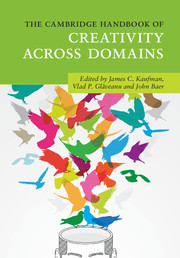Book contents
- The Cambridge Handbook of Creativity Across Domains
- The Cambridge Handbook of Creativity Across Domains
- Copyright page
- Dedication
- Contents
- Figures
- Tables
- Contributors
- Acknowledgments
- Part I Creativity and Domain
- 1 Creativity Across Different Domains
- 2 The Amusement Park Theoretical Model of Creativity
- 3 Mix and Match
- 4 Domain-General Creativity
- Part II Creativity in the Traditional Arts
- Part III Creativity in the Sciences
- Part IV Creativity in Business
- Part V Newer Domains for Creativity Research
- Part VI Creativity in Everyday Life
- Part VII Conclusion
- Index
- References
4 - Domain-General Creativity
On Generating Original, Useful, and Surprising Combinations
from Part I - Creativity and Domain
Published online by Cambridge University Press: 15 September 2017
- The Cambridge Handbook of Creativity Across Domains
- The Cambridge Handbook of Creativity Across Domains
- Copyright page
- Dedication
- Contents
- Figures
- Tables
- Contributors
- Acknowledgments
- Part I Creativity and Domain
- 1 Creativity Across Different Domains
- 2 The Amusement Park Theoretical Model of Creativity
- 3 Mix and Match
- 4 Domain-General Creativity
- Part II Creativity in the Traditional Arts
- Part III Creativity in the Sciences
- Part IV Creativity in Business
- Part V Newer Domains for Creativity Research
- Part VI Creativity in Everyday Life
- Part VII Conclusion
- Index
- References
Summary
The author argues that all creative ideas, whether in the arts or the sciences, use the same set of generic processes and procedures – just as persons speaking different languages operate under the same fundamental linguistic principles. The argument begins with the basic observation that all forms of creativity are combinatorial, the generation of new combinations from given ideas. However, because not all combinations are creative, it is necessary to provide a formal definition of what can be considered such. In words, creativity is defined as the joint product of its originality, utility, and surprise. This definition then implies that combinations must be generated by a procedure or process that is blind to the utility values. However, blindness does not imply the lack of constraints on the chosen combinatorial mechanism. The chapter then closes with a discussion of the theory’s explanatory scope, research applications, and theoretical syntheses.
- Type
- Chapter
- Information
- The Cambridge Handbook of Creativity across Domains , pp. 41 - 60Publisher: Cambridge University PressPrint publication year: 2017
References
- 8
- Cited by



